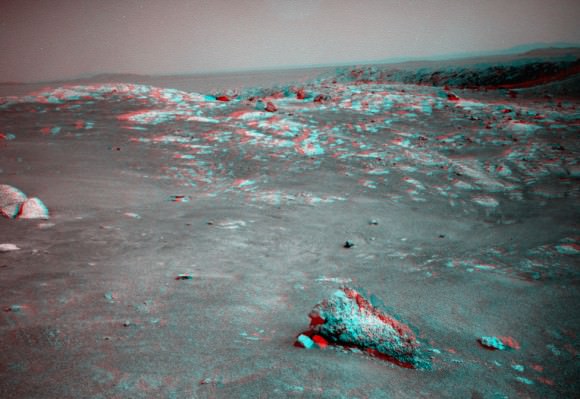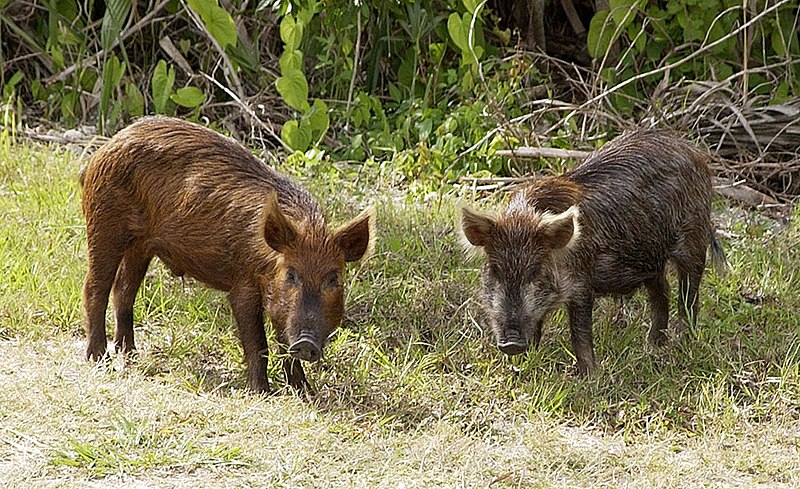A stegosaurus near Santa Maria crater!
- neufer
- Vacationer at Tralfamadore
- Posts: 18805
- Joined: Mon Jan 21, 2008 1:57 pm
- Location: Alexandria, Virginia
A stegosaurus near Santa Maria crater!
Art Neuendorffer
Re: A stegosaurus near Santa Maria crater!
Looks more like a razor back to me
- neufer
- Vacationer at Tralfamadore
- Posts: 18805
- Joined: Mon Jan 21, 2008 1:57 pm
- Location: Alexandria, Virginia
Re: A stegosaurus near Santa Maria crater!
BMAONE23 wrote:
Looks more like a razor back to me
http://en.wikipedia.org/wiki/Razorback wrote:<<Domestic pigs were first introduced to the Americas in the 16th century. Christopher Columbus is known to have intentionally released domestic swine in West Indies during his second voyage in order to provide future expeditions with a freely available food supply. Hernando de Soto is known to have introduced Eurasian domestic swine to Florida in 1539, although Juan Ponce de León may have introduced the first pigs into mainland Florida in 1525. The practice of introducing domestic pigs into the New World continued throughout the exploration periods of the sixteenth and seventeenth centuries. It is thought that the Eurasian wild boar (Sus scrofa scrofa), which originally ranged from Great Britain to European Russia may have also been introduced.
In South America, during the early 20th century, free-ranging boars were introduced in Uruguay for hunting purposes and eventually crossed the border into Brazil in the 1990s, quickly becoming an invasive species. Licensed private hunting of both feral boars and hybrids (javaporcos) was authorized from August 2005 on in the Southern Brazilian state of Rio Grande do Sul, although their presence as a pest had been already noticed by the press as early as 1994. Releases and escapes from unlicensed farms (established because of increased demand for boar meat as an alternative to pork), however, continued to bolster feral populations and by mid-2008 licensed hunts had to be expanded to the states of Santa Catarina and São Paulo.
Recently-established Brazilian boar populations are not to be confused with long established populations of feral domestic pigs (porcos monteiros), which have existed mainly in the Pantanal for more than a hundred years, along with native peccaries. The demographic dynamics of the interaction between feral pigs populations and those of the two native species of peccaries (Collared Peccary and White-lipped Peccary) is obscure and is being studied presently. It has been proposed that the existence of feral pigs could somewhat ease jaguar predation on peccary populations, as jaguars would show a preference for hunting pigs, when these are available.
The most widely-recognized appearance of the razorback or wild boar in American popular culture is as the sports mascot for the University of Arkansas in Fayetteville. The mascot's name is Tusk. The Arkansas Razorbacks' logo is a razorback hog, seen in silhouette, usually red on white or white on red. Moreover, the University of Arkansas' unique sports cheer is known as "Calling the Hogs." The chant is usually written as "Woo Pig Sooie," ostensibly the call used by domestic hog farmers to bring their stock to the trough for feeding (thus arguably recognizing that the original "hogs" were, in fact, domestic swine, despite the razorback living in the wild as a feral animal today).>>
Art Neuendorffer
- neufer
- Vacationer at Tralfamadore
- Posts: 18805
- Joined: Mon Jan 21, 2008 1:57 pm
- Location: Alexandria, Virginia
Re: A stegosaurus near Santa Maria crater!
http://www.universetoday.com/81789/powerful-mars-orbiter-directs-opportunity-to-clays-and-hydrated-minerals/#more-81789 wrote:
Powerful Mars Orbiter Directs Opportunity to Clays and Hydrated Minerals
by Ken Kremer on December 17, 2010
<<An armada of orbiters and rovers from Earth are carrying out a coordinated attack plan to unlock the mysteries of the red planet, foremost being to determine whether life ever arose on Mars. NASA is using its powerful science surveyor orbiting more than 241 kilometers above Mars to target the surface explorations of the long lived Opportunity rover to compelling science targets on the ground. Opportunity is currently on a long term trek to the giant crater named Endeavour, some 22 kilometers in diameter, which shows significant signatures of clays and water bearing sulfate minerals which formed in the presence of flowing liquid water billions of years ago. On Dec. 15 (Sol 2450), Opportunity arrived at Santa Maria crater which is just 6 km distant from the western rim of Endeavour. Over the past 2 years, the rover has traversed more than two thirds of the 19 km distance from Victoria crater -her last big target – to Endeavour.
- Map indicates geological units in the region of Mars around a smaller area where Opportunity has driven through late 2010. The blue-coded unit encompassing most of the southern half of the mapped region is ancient cratered terrain. The northern region is overlain by younger sediments of the Meridiani Plains, punctuated by the even younger Bopulu impact. At Endeavour Crater, in the upper right near the gold line of Opportunity's traverse, ancient cratered terrain is exposed around the crater rim. Locations where orbital observations have detected clay minerals are indicated at the western edge of Endeavour and at two locations in the southern portion of the map. The mineral mapping was done by Sandra Wiseman & Ray Arvidson of Washington Universty based on observations by the Compact Reconnaissance Imaging Spectrometer for Mars (CRISM) on NASA's MRO.
- Opportunity just arrived at the western side of Santa Maria Crater, some 90 meters wide, on 15 December 2010. Researchers are using data collected by a powerful mineral mapping spectrometer (CRISM) aboard NASA’s Mars Reconnaissance Orbiter (MRO) to direct the route which Opportunity is traversing on Mars during the long term journey to Endeavour crater. Spectral observations recorded by CRISM indicates the presence of water-bearing sulfate minerals at the location shown by the red dot on the southeast rim crater whereas the crater floor at the blue dot does not. This image was taken by the the High Resolution Imaging Science Experiment (HiRISE) camera also on MRO. Credit: NASA/JPL-Caltech/Univ. of Arizona
High resolution spectral and imaging mappers aboard NASA’s Mars Reconnaissance Orbiter (MRO) are enabling researchers on the rover team to prioritize targets and strategically guide Opportunity to the most fruitful locations for scientific investigations. The on board CRISM mapping spectrometer has detected clay minerals, or phyllosilicates, at multiple locations around Endeavour crater including the western rim closest to Opportunity. CRISM is the acronym for Compact Reconnaissance Imaging Spectrometer for Mars. Images from MRO’s HiRISE camera are utilized to scout out the safest and most efficient route. “This is the first time mineral detections from orbit are being used in tactical decisions about where to drive on Mars,” said Ray Arvidson of Washington University in St. Louis. Arvidson is the deputy principal investigator for the Spirit and Opportunity rovers and a co-investigator for CRISM.
Clay minerals are a very exciting scientific find because they can form in more neutral and much less acidic aqueous environments which are more conducive to the possibility for the formation of life. They have never before been studied up close by science instruments on a landed mission. Opportunity may soon get a quick taste of water bearing sulfate minerals at Santa Maria because spectral data from CRISM suggest the presence of sulfate deposits at the southeast rim of the crater. Opportunity has previously investigated these sulfate minerals at other locations along her circuitous traverse route – but which she discovered without the help of orbital assets. “We’ve just pulled up to the rim of Santa Maria, and the workload is very high,” Steve Squyres informed me. Opportunity drove to within about 5 meters of the crater rim on Dec. 16 (Sol 2451). JPL Mars rover driver Scott Maxwell tweeted this message ; “Today’s NAVCAM mosaic of Santa Maria Crater. Woo-hoo! Glorious and beautiful!” The rover will conduct an extensive science campaign at Santa Maria by driving to different spots over the next several weeks and gathering data to compare observations on the ground to those from CRISM in orbit. Santa Maria crater appears to be relatively fresh and steep walled and was likely created by a meteor strike only a few million years ago. Endeavour is an ancient crater with a discontinuous rim that is heavily eroded at many points. By exploring craters, scientists can look back in time and decipher earlier geologic periods in Mars history.
Scientists believe that the clay minerals stem from an earlier time period in Martian history and that the sulfate deposits formed later. Mars has experiences many episodes of wet environments at diverse locations in the past and climate-change cycles persist into the present era. After the upcoming Solar Conjunction in February 2011, Opportunity will depart eastwards for the last leg of the long march to Endeavour. She heads for a rim fragment dubbed Cape York which spectral data show is surrounded by exposures of water bearing minerals. Cape York is not yet visible in the long distance images because it lies to low.
Thereafter, Opportunity alters direction and turns south towards her next goal – Cape Tribulation – which is even more enticing to researchers because CRISM has detected exposures of the clay minerals formed in the milder environments more favorable to life. Cape Tribulation has been clearly visible in rover images already taken months ago in early 2010. Opportunity could reach Endeavour sometime in 2011 if she can continue to survive the harsh environment of Mars and drive at her current accelerated pace. Opportunity arrived at Mars in January 2004 for a planned 90 day mission. The rover has far surpassed all expectations and will soon celebrate 7 earth years of continuous operations on the red planet. Virtually all the data from Spirit and Opportunity are relayed back to Earth via NASA’s Mars Odyssey orbiter.>>
Art Neuendorffer
Re: A stegosaurus near Santa Maria crater!
I agree, but i would also add that it looks pretty well stonedBMAONE23 wrote:Looks more like a razor back to me
To find the Truth, you must go Beyond.
Re: A stegosaurus near Santa Maria crater!
Hey neufer, after i made my last post, i scrolled up and your 'stegosaurus' picture was showing in 3-D colors. when i left and came back, it was back to a normal picture. You got any idea as to why it showed in 3-D colors after posting, but before clicking on board index.?? I just scrolled down while making this post and it shows the red and blue-green again. And NO, i haven't been drinking those strange smelling multicolored drinks at Milliways 
To find the Truth, you must go Beyond.
Re: A stegosaurus near Santa Maria crater!
beyond wrote:You got any idea as to why it showed in 3-D colors after posting, but before clicking on board index.??
Maybe because you are looking at two different images.
Know the quiet place within your heart and touch the rainbow of possibility; be
alive to the gentle breeze of communication, and please stop being such a jerk. — Garrison Keillor
alive to the gentle breeze of communication, and please stop being such a jerk. — Garrison Keillor
Re: A stegosaurus near Santa Maria crater!
BOY! Those drinks at Milliways have longer lasting effects than i thought!! I didn't even notice that there were two different pictures. I need a vacation 
To find the Truth, you must go Beyond.





